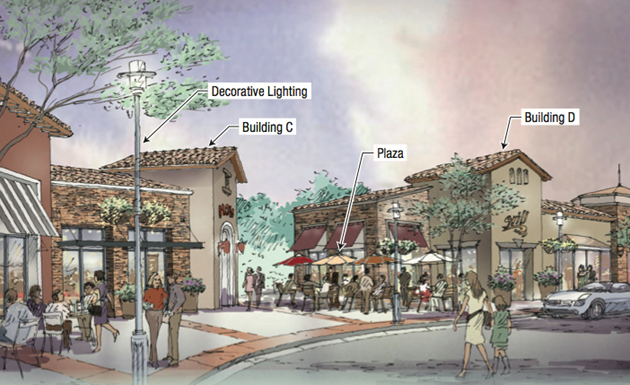Goleta City Council Sends Westar Development Back to the Drawing Board
Traffic, Accessibility Issues, and Zoning Challenges Force the Council to Reconsider

Arguments over the latest Westar project were made in a long, difficult Goleta City Council meeting on September 19. Nearly all the pros and cons were fundamental, and all were complicated by the existing Westar/Hollister Village development: Housing is needed and the proximity to work and shops is even better; Westar has caused a nightmare of traffic. People who can’t climb stairs need elevators; the added height of the rooftop shafts will further obliterate views. Rooftop gardens add views; rooftop gardens are no substitute for open space. Development at that spot is approved; the proposal is too big.
At issue was a General Plan amendment needed to change zoning from the previously approved work/live units and shops to the currently proposed pair of two-story buildings to house 33 apartments. The latter were written into a settlement by Westar of neighbor Patricia Moreno’s 2013 lawsuit. Though she’d sued the entire project over a lack of alternatives in the environmental report and traffic impacts, the settlement only affected the “triangle property.” Moreno is enjoined from opposing the project any more, but her neighbors in Pacific Glen came out to tell the council that Westar’s buildings loomed over them, right into their bedroom windows, costing them privacy and property damage from runoff. One who rode her bicycle to work described the journey as “scary,” with crossing times too short to get across the street.
The amount of traffic at Storke and Hollister is truly astonishing. In the late afternoon, the red lanes of online traffic maps extend from the northbound 101 offramp at Glen Annie through the Hollister intersection and all the way to the Home Depot/Marketplace entrance. Councilmembers affirmed that they and people they’d spoken with who lived nearby used the Winchester/Cathedral Oaks overpass three miles to the west to avoid Storke and Hollister. Residents spoke of the impossibility of exiting onto Hollister during peak hours. Timing the traffic lights will help, said Public Works director Rosemarie Gaglione, adding that they’d just found the “guru” who could do that and eliminate the backups from light to light.
Councilmember Roger Aceves was the only one willing to vote for the new proposal — bolstered by the 15 people who spoke in its favor, many employed or living at Westar — saying, “I love Option B.” He thought elevators were needed for the elderly as well as the disabled and reminded that the two-story project was preferable to the original three-story live/work buildings.
Mayor Paula Perotte was one of the council who said she used the Winchester alternative and had been the sole vote against Westar back in 2012. She added her “no” vote to the 4:1 majority against, as did councilmembers Kyle Richards, Stuart Kasdin, and Michael Bennett, agreeing with the 40 or so who’d written in protest of the project and the 11 who spoke in person during the three-hour session. If the developer wanted to try again, Richards suggested, Westar could try to find benefits the city needed, like affordable housing or more studio apartments, and try to avoid the density problem.
Bennett took the long view, stating he’d just returned from the League of Cities meeting in Sacramento and warning of more loss of local control to come from two bills in the Legislature. He also reminded that the Regional Housing Need Allocation (RHNA) would not go away, a state mandate to increase housing statewide incorporated into Goleta’s General Plan. The Housing Element of the 2014 General Plan showed a total of 546 units remained to be built. Of those, 42 percent were designated low or very low income.
Before voting against the project, Mayor Pro Tem Stuart Kasdin put a spin on the idea of location, saying that with 266 units already there, was this the place for 33 more? He found it “surreal” that people said Hollister Village was beautiful and beloved, when outside the development, the feeling was that it was an unwanted taste of Orange County, traffic, and “a sea of parking with buildings lurching onto the street.” It was what compelled him to run for office in the first place, he said.
“Goleta looked, in a way, like a place that God went on vacation to, and that isn’t the case now,” he said. “Where I live, it’s been changed. If there’s something that can be done, I’d appreciate it.”



